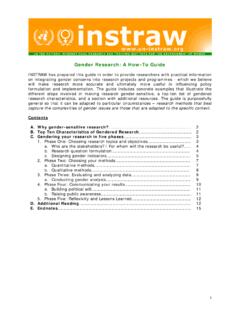Transcription of Stakeholder Analysis Guidelines
1 Section 2 Stakeholder AnalysisGuidelinesKammi SchmeerSection 26 WDNHKROGHU $QDO\VLV *XLGHOLQHV Table of ContentsIntroduction .. 2-1 Step 1: Planning the Process .. 2-3 Step 2: Selecting and Defining a Policy.. 2-5 Step 3: Identifying Key Stakeholders .. 2-6 Step 4: Adapting the Tools .. 2-8 Step 5: Collecting and Recording the Information .. 2-13 Step 6: Filling in the Stakeholder Table .. 2-15 Step 7: analyzing the Stakeholder Table .. 2-19 Step 8: Using the Information .. 2-23 Bibliography .. 2-33 Annex 2-A: Sample General List of Stakeholders .. 2-34 Annex 2-B: Definitions of Stakeholder Characteristics and Instructions for Filling in Stakeholder Table.. 2-35 Annex 2-C: Sample Stakeholder Table .. 2-38 Annex 2-D: Sample Stakeholder Interview Questionnaire .. 2-40 Annex 2-E: Sample Information Transfer Reference Chart.
2 2-43 List of Boxes, Figures, and TablesBox Sample policies .. 2-5 Box Sample health reform policy definitions .. 2-5 Box Potential Stakeholder groups for a national-level health reform policy .. 2-6 Box secondary information sources .. 2-13 Box conclusions on the deconcentration of the MOH .. 2-29 Box general strategies for increasingsupport for deconcentration of the MOH ..2-30 Figure The Policy Process ..2-2 Figure Spectrum of Stakeholder Positions ..2-16 Figure Use All Tools in Filling in the Analysis Table (See Annexes for full versions) ..2-18 Figure Sample of How to Use PowerPoint to Present Power/Leadership Analysis Results ..2-24 Figure Sample Position Map ..2-25 Figure PowerPoint Presentation of Knowledge Data ..2-27 Figure PowerPoint Presentation of Key Alliances.
3 2-28 Figure Sample Presentation of Strategies in PowerPoint ..2-30 Figure Matrix for Identifying Stakeholders to Be Targeted by Strategies ..2-32 Table Characteristics and Table Titles (full table in Annex 2-C) ..2-9 Table Chart (question numbersthat pertain to each column on the Stakeholder table) 2-12 Table E of Stakeholder Table ..2-15 Table H and I of Stakeholder Table ..2-17 Table Results of Power/Leadership Analysis ..2-20 Stakeholder Analysis at a GlanceWhat Is Stakeholder Analysis ? Stakeholder Analysis is a process of systematically gathering and analyzing qualitative infor-mation to determine whose interests should be taken into account when developing and/or implementing a policy or Is a Stakeholder ? Stakeholders in a process are actors (persons or organizations) with a vested interest in the pol-icy being promoted.
4 These stakeholders, or interested parties, can usually be grouped into the following categories: international/donors, national political (legislators, governors), public (ministry of health [MOH], social security agency, ministry of finance), labor (unions, medical associations), commercial/private for-profit, nonprofit (nongovernmental organizations [NGOs], foundations), civil society, and users/consumers. Which Stakeholder Characteristics Are Analyzed? The Analysis includes such Stakeholder characteristics as knowledge of the policy, interests related to the policy, position for or against the policy, potential alliances with other stakeholders, and ability to affect the policy process (through power and/or leadership). Why Is this Analysis Useful? Policymakers and managers can use a Stakeholder Analysis to identity the key actors and to assess their knowledge, interests, positions, alliances, and importance related to the policy.
5 This allows policymakers and managers to interact more effectively with key stakeholders and to increase support for a given policy or program. When this Analysis is conducted before a policy or program is implemented, policymakers and managers can detect and act to prevent potential misunderstandings about and/or opposition to the policy or program. When a Stakeholder Analysis and other key tools are used to guide the implementation, the policy or program is more likely to Are the Steps in Stakeholder Analysis ?There are eight major steps in the the and defining a key the and recording the in the Stakeholder the Stakeholder the informationWhat Can Be Achieved with Stakeholder Analysis ? Stakeholder Analysis yields useful and accurate information about those persons and organiza-tions that have an interest in health reform.
6 This information can be used to provide input for other analyses; to develop action plans to increase support for a reform policy; and to guide a participatory, consensus-building increase support or build consensus for reform, policymakers and managers must take additional steps following the Stakeholder Analysis . In the next phases of the policy process constituency-building, resource mobilization, and implementation policymakers and man-agers should use the information generated by the Stakeholder Analysis to develop and imple-ment strategic communication, advocacy, and negotiation plans. The other sections of this toolkit can be used to guide the development and implementation of such plans (see, for exam-ple, Section 3: Advocacy Guidelines , and Section 4: Conflict Negotiation Guidelines ).
7 Section 2 Stakeholder Analysis GuidelinesIntroductionIn developing this document, Partnerships for Health Reform (PHR) addresses one aspect of managing the politics of the reform process: the need for information on key players who have an investment in proposed reforms. This is particularly important at the policy formula-tion and legitimation phase of the policy process (see Figure ). Policymakers and managers can use Stakeholder Analysis to identify these key players or stakeholders, predict whether they might support or block the implementation of health reforms, and develop strategies to pro-mote supportive actions and decrease opposing actions before attempting to implement major reform at the national, regional, local, or facility purpose of this document is to help policymakers, managers, and their working groups follow an objective and systematic process for collecting and analyzing data about key health reform stakeholders.
8 It should be noted, however, that even the application of the systematic methodology incorporated into these Guidelines cannot prevent the information from being somewhat subjective since Stakeholder Analysis is based on what stakeholders communicate to analysts. These Guidelines , however, do include suggestions for checking the consistency of answers and other mechanisms to ensure that the information is obtained and analyzed as objectively as document was developed using a thorough review of the literature on Stakeholder anal-ysis, political mapping, and policy process, as well as PHR field experience in conducting stake-holder analyses. (Health reform Stakeholder analyses were conducted with PHR support in Ecuador and India.) The resulting document, therefore, includes instructions and tools that are supported by both academic theory and real-world Guidelines incorporate a methodology that yields useful and accurate information on health reform stakeholders (and can be followed even when conducting a Stakeholder Analysis with limited time or resources).
9 The information resulting from the Analysis can be used for the following: Provide input for other analyses ( , strategic planning, institutional assessment, broader political analyses)2-2 Policy Toolkit for Strengthening Health Sector Reform Develop action plans to increase support for a reform policy Guide a participatory, consensus-building process (by sharing the information obtained with the stakeholders and encouraging discussion about how to address the concerns of the opposition). Application of these Guidelines is intended to make policymakers and managers more informed about the political environment surrounding their reforms and better prepared to take action to ensure the full implementation of health sector increase support or build consensus for reform, policymakers and managers must take additional steps following the Stakeholder Analysis .
10 In the next phases of the policy process constituency-building, resource mobilization, and implementation (Figure ) policymak-ers and managers should use the information generated by the Stakeholder Analysis to develop and implement strategic communication, advocacy, and negotiation plans. The other sections of this toolkit can be used to guide the development and implementation of such plans (see, for example, Section 3: Advocacy Guidelines , and Section 4: Conflict Negotiation Guidelines ). 3 ROL \ DV XVHG LQ WKLV GR XPHQW UHIHUV WR DQ\ QD WLRQDO UHJLRQDO OR DO RU LQ VWLWXWLRQDO SURMH W SURJUDP ODZ UHJXODWLRQ RU UXOH Figure The Policy Process,VVXHV$JHQGDV'H LVLRQV3 ROL \ )RUPXODWLRQ DQG/HJLWLPDWLRQ&RQVWLWXHQ \ %XLOGLQJ5 HVRXU H0 RELOL]DWLRQ,PSOHPHQWDWLRQ 'HVLJQ DQG 2 UJDQL]DWLRQDO 6 WUX WXULQJ3 URJUHVV ,PSD W0 RQLWRULQJ= SULPDU\ OLQNDJH= VH RQGDU\ OLQNDJH3 ROLWL DOO\ GRPLQDWHG7H KQL DOO\ OHG,VVXHV$JHQGDV'H LVLRQV,VVXHV$JHQGDV'H LVLRQV3 ROL \ )RUPXODWLRQ DQG/HJLWLPDWLRQ&RQVWLWXHQ \ %XLOGLQJ5 HVRXU H0 RELOL]DWLRQ,PSOHPHQWDWLRQ 'HVLJQ DQG 2 UJDQL]DWLRQDO 6 WUX WXULQJ3 URJUHVV ,PSD W0 RQLWRULQJ= SULPDU\ OLQNDJH= VH RQGDU\ OLQNDJH3 ROLWL DOO\ GRPLQDWHG7H KQL DOO\ OHGS takeholder Analysis Guidelines2-3 Step 1.















